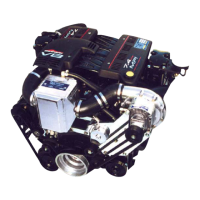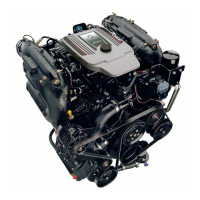Section 3 - On The Water
90-899883179 OCTOBER 2007 Page 35
• Clean, free of barnacles and marine growth
• Free of distortion; nearly flat where it contacts the water
• Straight and smooth, fore and aft
Marine vegetation may accumulate when the boat is docked. This growth must be removed
before operation; it may clog the water inlets and cause the engine to overheat.
Cavitation
Cavitation occurs when water flow cannot follow the contour of a fast‑moving underwater
object such as a gear housing or a propeller. Cavitation increases propeller speed while
reducing boat speed. Cavitation can seriously erode the surface of the gear housing or the
propeller. Common causes of cavitation are:
• Weeds or other debris snagged on the propeller
• Bent propeller blade
• Raised burrs or sharp edges on the propeller
Ventilation
Ventilation is caused by surface air or exhaust gases that are introduced around the
propeller resulting in propeller speed‑up and a reduction in boat speed. Air bubbles strike
the propeller blade and cause erosion of the blade surface. If allowed to continue, eventual
blade failure (breakage) will occur. Excessive ventilation is usually caused by:
• Drive unit trimmed out too far.
• A missing propeller diffuser ring.
• A damaged propeller or gear housing, which allows exhaust gases to escape between
propeller and gear housing.
• Drive unit installed too high on transom.
Elevation and Climate
Elevation and climate changes will affect the performance of your power package. Loss of
performance can be caused by:
• Higher elevations
• Higher temperatures
• Low barometric pressures
• High humidity
For you to have optimum engine performance under changing weather conditions, it is
essential that the engine be propped to allow the engine to operate at or near the top end
of the specified maximum RPM range with a normal boat load during your normal boating
weather conditions.
In most cases, recommended RPM can be achieved by changing to a lower pitch propeller.
Propeller Selection
IMPORTANT: The engines covered in this manual are equipped with an RPM rev‑limiter
that is set to an upper RPM limit. This limit, which is slightly above the normal operating
range of the engine, helps prevent damage from excessive engine RPM. Once the RPM
returns to the recommended operating RPM range, normal engine operation resumes.
The boat manufacturer and the selling dealer are responsible for equipping the power
package with the correct propeller. Refer to Mercury Marine's web page http://
www.mercurymarine.com/everything_you_need_to_know_about_propellers6.
Select a propeller that will allow the engine power package to operate at or near the top
end of the recommended WOT operating RPM range with a normal load.

